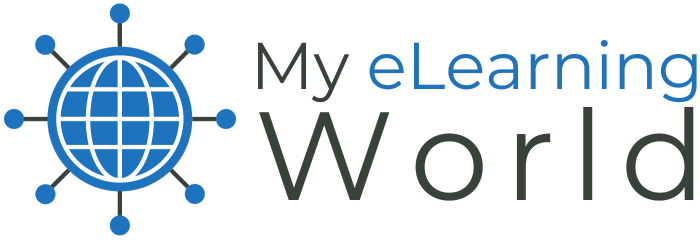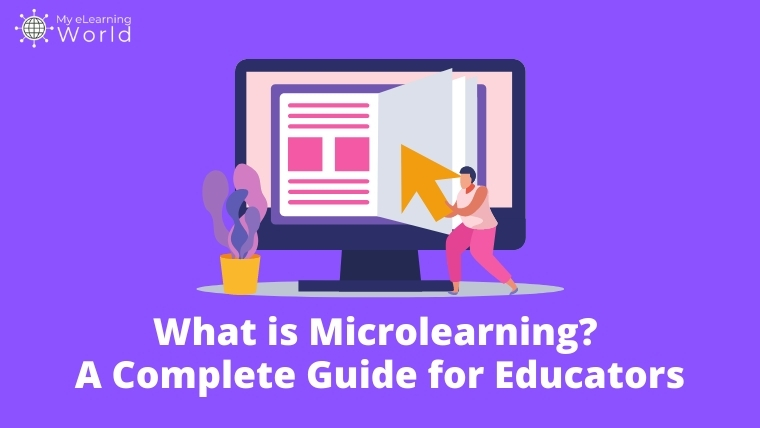What is microlearning? And why are so many trainers and educators talking about its benefits for skill development and memory retention?
Consider the following:
How many times have you presented a lesson to only have students stare at you in confusion following its delivery? The plethora of content that you packed into an energy-filled lesson was reduced to at least one-half of the students asking, ¨What did you say?¨
Okay, okay – this illustration might be a bit exaggerated; nonetheless, finding a way to present content in the most impactful way possible is a necessity in today’s fast-paced world.
As an educator, one solution is something called microlearning.
To better understand microlearning, let’s take a closer look at what it is, the key benefits, some potential drawbacks to this learning technique, and some best practices for creating these educational materials.
What is Microlearning?
Microlearning is an effective teaching tool that breaks down learning into smaller, bite-sized units. This type of educational content is often more convenient and more engaging for students to consume.
This content can be shared using a number of mediums including reading texts to interactive multimedia resources to how to videos.
The important takeaway is that microlearning training always means keep it short.
Microlearning Content Examples
There are a number of ways to get microlearning content into the hands of your learners for knowledge and skill development.
Providing them with texts such as phrases or short paragraphs is one option.
Alternatively, presenting them with photos, illustrations, a short Google Slides presentation with voiceover, or diagrams is another option.
Short audio and/or video clips (like the 5-10 minute lessons you see on MasterClass and other eLearning platforms), games, and even tests and quizzes all represent microlearning content.
When choosing content types, make sure to check with your eLearning provider to ensure that the app you’re using supports these types of content.
Why Does Microlearning Work?
You may be wondering: why are small learning units so effective for knowledge retention?
Simply put, today people are used to using their smartphones to acquire small chunks of information quickly as they are needed (it’s also why Just in Time Learning is so effective).
With the smartphone’s surge in popularity, educators realized this was a great way to deliver content and engage learners in today’s fast-paced, on-the-go world.
Regardless of whether someone is a student or an employee, everyone is busy today, and getting access to the educational content they need quickly and easily is essential to achieving a specific learning outcome.
The microlearning model makes it easy to dispense content in short bursts that pair well with people´s shortened attention spans.
This model can be used in schools, employee onboarding, corporate training, compliance training, skills training, and many other applications.
Microlearning Benefits are Undeniable
To better understand what is microlearning, let’s take a closer look at its benefits.
1. Small learning units improve focus.
Using short, targeted educational content supports long-term retention of said content.
Studies reveal employees may forget up to 80% of what they learn during training if it is not reinforced. However, microlearning lessons improve knowledge retention by up to 80% according to some case studies.
Bite-sized learning content is readily accessible, so learners feel more at ease learning when they are ready. They don’t have to feel like they have hours to study before they can tune in and learn something new.
Furthermore, this style of learning presents bite-sized pieces of key information, so irrelevant content is omitted, thereby making retention easier for everyone.
2. Preferred by learners.
With only 1-2 learning objectives per microlearning session, learners prefer this educational method of bite-sized courses.
It meets the needs of modern learners because it is on-demand, informal, and more engaging than other content delivery methods.
Lengthy learning tasks can kill learners’ motivation; on the other hand, microlearning keeps learners engaged from start to finish. Rather than wasting time with attention grabbers and lengthy explanations, this style of learning makes it possible for learners to get what they need in minimal time.
3. Aligns well with learners’ working memories.
Did you know that learning typically occurs in stretches of three to seven minutes?
When content is aligned to match this time span, it pairs well with what students can remember from one session.
The attention and capacity span of humans is very similar to the microlearning model that creates lessons that are this ideal length for keeping the learner’s attention span.
4. It’s faster to deliver.
Educators are able to create microlearning content with less preparation.
Since there are fewer things included, shorter course delivery times are feasible. A course with dozens of units can be created in only a couple of hours with the right video presentation software or other app for the medium of content you’re creating.
Who doesn’t want to free up some time without feeling like you’re cheating your students out of knowledge they need?
5. Reduced costs.
Microlearning courses are cheaper to produce because fewer resources and instructors are needed. There are no fancy microlearning tools needed — just some basics like a decent computer, some cheap voice over equipment, decent software, and that’s about it. If you have access to a regular LMS content editor, then you are well on your way to designing microlearning content.
6. Greater flexibility and freedom.
Microlearning allows learners to find flexibility. Educators can design content with diverse options that give learners more choices to develop new skills and gain new knowledge.
Text-heavy courses can be cumbersome for busy students, but microlearning allows learners to explore content in a casual way in their spare time as their busy schedule allows.
Since microtraining courses are small, learners can often download them and access them even when they are offline.
7. Reduces costs.
Printing training materials, course booklets, and other resources can be expensive.
Microeducation makes it possible to reduce the costs associated with dispersing content to students.
Furthermore, the need for a physical space takes on less importance when using a microlearning approach.
8. Easier to update materials.
Because microlearning courses are brief, updating materials is easier. This reality makes it easier to give students the most current information.
Complex eLearning courses often mean that outdated materials can get buried in all the information, but that doesn’t have to be the case with microlearning.
Does Microlearning Have Limitations?
Conventional eLearning definitely differs from microlearning. One cannot say it is better than or worse than some other options, but there are some notable limitations to microlearning.
1. Complex concepts don’t work as well.
Microlearning is ideal for simple information. If more complex concepts are being taught, that content will have to be broken down into multiple microlessons.
For example, if a teacher is trying to get students to differentiate Food Webs and Food Chains, this comparison cannot be fully made after a single microlearning session.
Instead, there will likely be 3-4 microlearning sessions before the full comparison is clear.
So, if you have complex topics that need to be explained in-depth and that can’t be broken out into short videos or lessons, microlearning might not be the best fit.
2. Not ideal for in-depth training.
If the subject matter being presented is in-depth, microlearning with bite-sized modules is likely not the best option. If you want to present a small preview of Colonial America, that’s very different from wanting to cover the entire American Revolution.
When content requires more than seven minutes to get the general concept across, microlearning is likely not the best approach. Some concepts are simply too in-depth and/or require much more exploration than what a course made up of microlessons was designed to be.
3. Combining elements to get one big picture.
Microlearning will not allow students to walk away seeing how different concepts combine to create a big idea. More in-depth learning options are needed for this type of content. Realizing that more sessions will be needed is definitely needed before jumping in with a microlearning course.
Best Practices for Creating Microlearning Content
If the benefits of microlearning outweigh the potential disadvantages, there are some best practices to keep in mind. Following these best practices will help you get it right as you set up your courses.
- Check to see if it is right for your course materials. If the subject matter is too complex, microlearning is likely not the best fit. Consider using it as a supplementary training method instead.
- Reduce, reduce, reduce. Regular eLearning materials cannot just arbitrarily be broken down into manageable pieces and called microlearning. Instead, microlearning requires using short and focused content that illustrates what you are trying to teach.
- Use relevant multimedia assets. Don’t rely exclusively on text. When selecting multimedia resources, make sure that they fit your purpose and are not there just to fill space or look pretty.
- Gamification for the win. If your eLearning platform offers gamification, use this resource as a way to boost engagement even more. Pairing gamification with mobile-based microlearning can be a winning combination. The competitive nature of gamification encourages students to learn as much as they can and then show off their knowledge in these classroom-type challenges.
- Assessing Progress. Mini tests, short quizzes, and other micro-assessments are excellent ways to ensure that progress aligns with training goals. Seeing how much students are learning will be another sure-fire way to ensure that students are getting what they need from the material. You might find these online quiz makers to be helpful.
Ready to Create Your Own Microlearning Content?
Education evolves. The methodologies that worked decades ago are no longer the best way to reach today’s learners.
Finding a way to embed microlearning into relevant and meaningful classes can truly be a way to motivate students. Their focus will increase, their mastery will soar, and they will find new levels of confidence!

